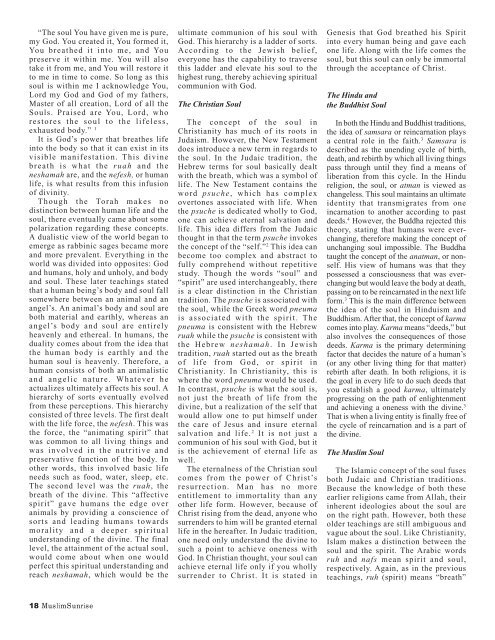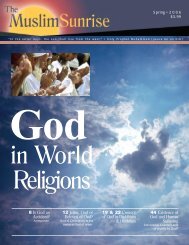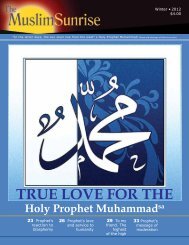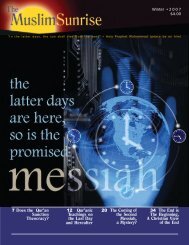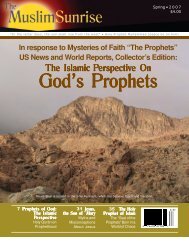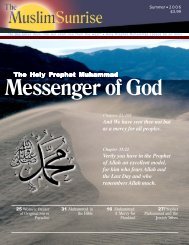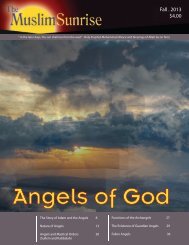You also want an ePaper? Increase the reach of your titles
YUMPU automatically turns print PDFs into web optimized ePapers that Google loves.
“<strong>The</strong> soul You have given me is pure,my God. You created it, You formed it,You breathed it into me, and Youpreserve it within me. You will alsotake it from me, and You will restore itto me in time to come. So long as thissoul is within me I acknowledge You,Lord my God and God of my fathers,Master of all creation, Lord of all theSouls. Praised are You, Lord, whorestores the soul to the lifeless,exhausted body.” 1It is God’s power that breathes lifeinto the body so that it can exist in itsvisible manifestation. This divinebreath is what the ruah and theneshamah are, and the nefesh, or humanlife, is what results from this infusionof divinity.Though the Torah makes nodistinction between human life and thesoul, there eventually came about somepolarization regarding these concepts.A dualistic view of the world began toemerge as rabbinic sages became moreand more prevalent. Everything in theworld was divided into opposites: Godand humans, holy and unholy, and bodyand soul. <strong>The</strong>se later teachings statedthat a human being’s body and soul fallsomewhere between an animal and anangel’s. An animal’s body and soul areboth material and earthly, whereas anangel’s body and soul are entirelyheavenly and ethereal. In humans, theduality comes about from the idea thatthe human body is earthly and thehuman soul is heavenly. <strong>The</strong>refore, ahuman consists of both an animalisticand angelic nature. Whatever heactualizes ultimately affects his soul. Ahierarchy of sorts eventually evolvedfrom these perceptions. This hierarchyconsisted of three levels. <strong>The</strong> first dealtwith the life force, the nefesh. This wasthe force, the “animating spirit” thatwas common to all living things andwas involved in the nutritive andpreservative function of the body. Inother words, this involved basic lifeneeds such as food, water, sleep, etc.<strong>The</strong> second level was the ruah, thebreath of the divine. This “affectivespirit” gave humans the edge overanimals by providing a conscience ofsorts and leading humans towardsmorality and a deeper spiritualunderstanding of the divine. <strong>The</strong> finallevel, the attainment of the actual soul,would come about when one wouldperfect this spiritual understanding andreach neshamah, which would be theultimate communion of his soul withGod. This hierarchy is a ladder of sorts.According to the Jewish belief,everyone has the capability to traversethis ladder and elevate his soul to thehighest rung, thereby achieving spiritualcommunion with God.<strong>The</strong> Christian Soul<strong>The</strong> concept of the soul inChristianity has much of its roots inJudaism. However, the New Testamentdoes introduce a new term in regards tothe soul. In the Judaic tradition, theHebrew terms for soul basically dealtwith the breath, which was a symbol oflife. <strong>The</strong> New Testament contains theword psuche, which has complexovertones associated with life. Whenthe psuche is dedicated wholly to God,one can achieve eternal salvation andlife. This idea differs from the Judaicthought in that the term psuche invokesthe concept of the “self.” 2 This idea canbecome too complex and abstract tofully comprehend without repetitivestudy. Though the words “soul” and“spirit” are used interchangeably, thereis a clear distinction in the Christiantradition. <strong>The</strong> psuche is associated withthe soul, while the Greek word pneumais associated with the spirit. <strong>The</strong>pneuma is consistent with the Hebrewruah while the psuche is consistent withthe Hebrew neshamah. In Jewishtradition, ruah started out as the breathof life from God, or spirit inChristianity. In Christianity, this iswhere the word pneuma would be used.In contrast, psuche is what the soul is,not just the breath of life from thedivine, but a realization of the self thatwould allow one to put himself underthe care of Jesus and insure eternalsalvation and life. 2 It is not just acommunion of his soul with God, but itis the achievement of eternal life aswell.<strong>The</strong> eternalness of the Christian soulcomes from the power of Christ’sresurrection. Man has no moreentitlement to immortality than anyother life form. However, because ofChrist rising from the dead, anyone whosurrenders to him will be granted eternallife in the hereafter. In Judaic tradition,one need only understand the divine tosuch a point to achieve oneness withGod. In Christian thought, your soul canachieve eternal life only if you whollysurrender to Christ. It is stated inGenesis that God breathed his Spiritinto every human being and gave eachone life. Along with the life comes thesoul, but this soul can only be immortalthrough the acceptance of Christ.<strong>The</strong> Hindu andthe Buddhist SoulIn both the Hindu and Buddhist traditions,the idea of samsara or reincarnation playsa central role in the faith. 3 Samsara isdescribed as the unending cycle of birth,death, and rebirth by which all living thingspass through until they find a means ofliberation from this cycle. In the Hindureligion, the soul, or atman is viewed aschangeless. This soul maintains an ultimateidentity that transmigrates from oneincarnation to another according to pastdeeds. 4 However, the Buddha rejected thistheory, stating that humans were everchanging,therefore making the concept ofunchanging soul impossible. <strong>The</strong> Buddhataught the concept of the anatman, or nonself.His view of humans was that theypossessed a consciousness that was everchangingbut would leave the body at death,passing on to be reincarnated in the next lifeform. 3 This is the main difference betweenthe idea of the soul in Hinduism andBuddhism. After that, the concept of karmacomes into play. Karma means “deeds,” butalso involves the consequences of thosedeeds. Karma is the primary determiningfactor that decides the nature of a human’s(or any other living thing for that matter)rebirth after death. In both religions, it isthe goal in every life to do such deeds thatyou establish a good karma, ultimatelyprogressing on the path of enlightenmentand achieving a oneness with the divine. 3That is when a living entity is finally free ofthe cycle of reincarnation and is a part ofthe divine.<strong>The</strong> <strong>Muslim</strong> Soul<strong>The</strong> Islamic concept of the soul fusesboth Judaic and Christian traditions.Because the knowledge of both theseearlier religions came from Allah, theirinherent ideologies about the soul areon the right path. However, both theseolder teachings are still ambiguous andvague about the soul. Like Christianity,Islam makes a distinction between thesoul and the spirit. <strong>The</strong> Arabic wordsruh and nafs mean spirit and soul,respectively. Again, as in the previousteachings, ruh (spirit) means “breath”18 <strong>Muslim</strong><strong>Sunrise</strong>


